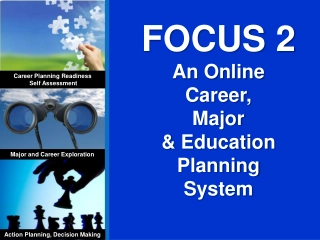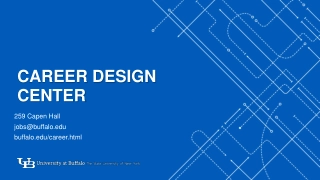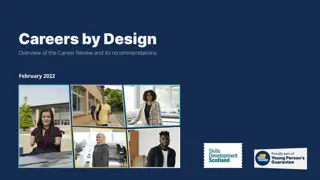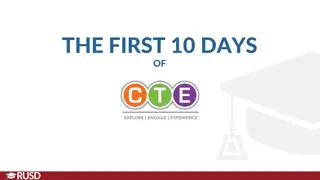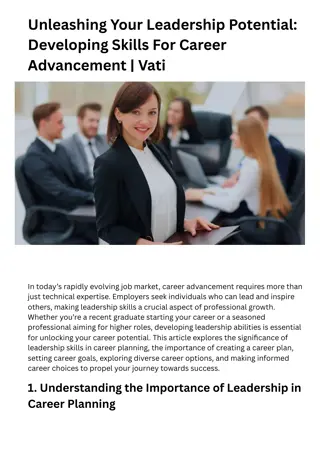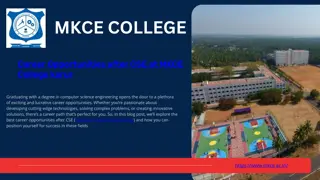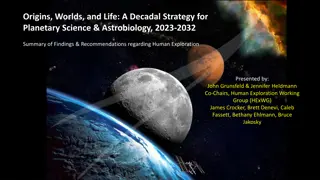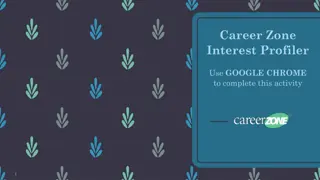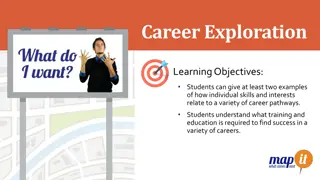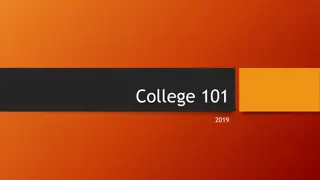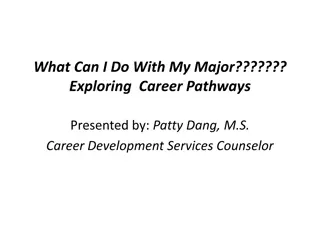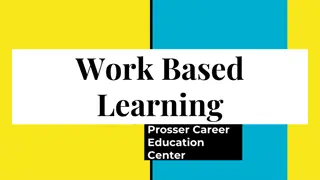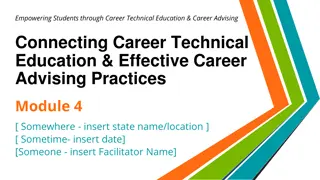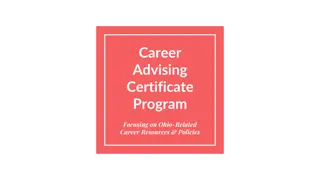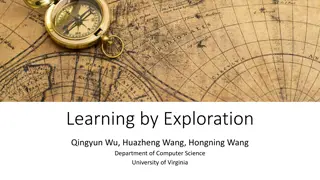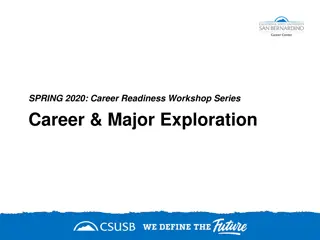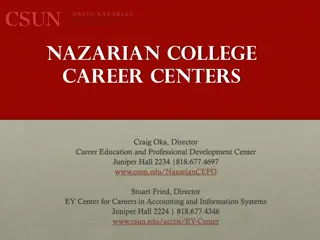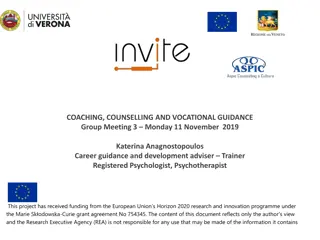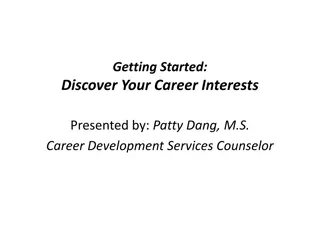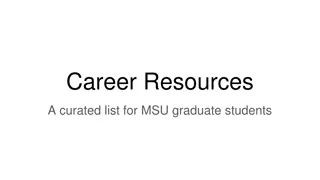Career Exploration
This chapter delves into motivations for attending college, correlating short-term goals with long-term ambitions, and defining college and career readiness. Explore employment rates, salaries, and career paths to gain insights for your future.
Download Presentation

Please find below an Image/Link to download the presentation.
The content on the website is provided AS IS for your information and personal use only. It may not be sold, licensed, or shared on other websites without obtaining consent from the author.If you encounter any issues during the download, it is possible that the publisher has removed the file from their server.
You are allowed to download the files provided on this website for personal or commercial use, subject to the condition that they are used lawfully. All files are the property of their respective owners.
The content on the website is provided AS IS for your information and personal use only. It may not be sold, licensed, or shared on other websites without obtaining consent from the author.
E N D
Presentation Transcript
Career Exploration Chapter 4
The Big Picture By the end of this section, you will be able to: Identify your motivations for attending college Correlate your short-term goals with longer-range ambitions Define college ready and career ready Describe how your longer-term goals might evolve, relative to your deepening experiences
Motivations For Attending College Read the list of motivations for attending college in your course text. Identify your top 5 reasons.
College and Career Ready What does it mean to be ready for college and a career? In general, you are a college- and career-ready student if you have gained the necessary knowledge, skills, and professional behaviors to achieve at least one of the following: Earn a certificate or degree in college Participate in career training Enter the workplace and succeed
Student Voices Student Voices on Being College and Career Ready https://youtu.be/9pYqsShxqD4
Employment Rates and Salaries Consider, too, the following statistics on employment rates and salaries for college graduates. College does make a big difference! The average college graduate earns about 75 percent more than a non-college graduate. In 2014, young adults ages 20 to 24 with a bachelor s degree or higher had a higher employment rate than young adults with just some college. The employment rate for young adults with just some college was higher than the rate for those who had completed high school. The employment rate for those who completed high school was higher than the employment rate for young adults who had not finished high school. Employment rates were generally higher for males than females at each level of educational attainment in 2014. Over the course of a forty-year working life, the typical college graduate earns an estimated $550,000 more than the typical high school graduate. The median gap in annual earnings between a high school and college graduate as reported by the U.S. Census Bureau in 2010 is $19,550. Perhaps most important, an overwhelming majority of college graduates 86 percent say that college has been a good investment for them personally.
Career Paths By the end of this section, you will be able to: Differentiate between job and career Explain the five-step process for choosing a career, which includes aligning your personal interests and skills with appropriate fields Identify sources for learning more about specific careers
Job vs. Career JOB CAREER A job refers to the work a person performs for a living. It can also refer to a specific task done as part of the routine of one s occupation. A person can begin a job by becoming an employee, or by volunteering, for example, by starting a business or becoming a parent. A career is an occupation (or series of jobs) that you undertake for a significant period of time in your life perhaps five or ten years, or more. A career typically provides you with opportunities to advance your skills and positions. Definitions A job you accept with an employer does not necessarily require special education or training. Sometimes you can get needed learning on the job. A career usually requires special learning perhaps certification or a specific degree. Requirements A career can also have risk. In today s world, employees need to continually learn new skills and to adapt to changes in order to stay employed. Starting your own business can have risks. Many people thrive on risk-taking, though, and may achieve higher gains. It all depends on your definition of success. A job may be considered a safe and stable means to get income. But jobs can also quickly change; security can come and go. Risk-Taking The duration of a job may range from an hour (in the case of odd jobs, for example,) to a lifetime. Generally a job is shorter-term. Duration A career is typically a long-term pursuit. Career-oriented jobs generally offer an annual salary versus a wage. Career-oriented jobs may also offer appealing benefits, like health insurance and retirement. Jobs that are not career oriented may not pay as well as career-oriented positions. Jobs often pay an hourly wage. Income Careers allow you to invest time and energy in
The Five-Step Process for Choosing Your Career Get to know yourself Get to know your field Prioritize your deal makers and rule out your deal breakers Make a preliminary career decision and create a plan of action Go out and achieve your career goal
College Majors By the end of this section, you will be able to: List key strategies for selecting a college major Identify the relationship between college majors and career paths (both why they matter and why they don t) Identify sources for learning more about specific majors and related careers
How to Select Your College Major Seek inspiration Consider everything Identify talents and interests Explore available resources In-depth career exploration https://youtu.be/8I_Qw2NfSq0
How to Select Your College Major The next video shares nine tips: https://youtu.be/V4dNoVsmU2o Narrow your choices by deciding what you don t like. Explore careers that might interest you. Ask questions. Use your school s resources. Ask your teacher, counselor, and family about your strengths. 60 percent of students change their majors. Your major isn t going to define your life. But choosing one that interests you will make your college experience much more rewarding. Go on informational interviews with people in careers that interest you. There s no pressure to decide now. Take new classes and discover your interests.
Helpful Resources College course catalog: Course catalogs are typically rich with information that can spark ideas and inspiration for your major and your career. Faculty and academic advisers at your college: Many college professors are also practitioners in their fields, and can share insights with you about related professions. Fellow students and graduating seniors: Many of your classmates, especially those who share your major, may have had experiences that can inform and enlighten you for instance, an internship with an employer or a job interview with someone who could be contacted for more information. Students who have graduated: Most colleges and universities have active alumni programs with networking resources that can help you make important decisions. Your family and social communities: Contact friends and family members who can weigh in with their thoughts and experience. A career center: Professionals in career centers have a wealth of information to share with you they re also very good at listening and can act as a sounding board for you to try out your ideas.
Professional Skill Building By the end of this section, you will be able to: List specific skills that will be necessary for your career path List transferable skills that will be valuable for any career path Explain how to acquire necessary skills, both in and out of class, for your career goals
Hard Skills and Soft Skills Hard skills are concrete or objective abilities that you learn and perhaps have mastered. They are skills you can easily quantify, like using a computer, speaking a foreign language, or operating a machine. You might earn a certificate, a college degree, or other credentials that attest to your hard-skill competencies. Obviously, because of changes in technology, the hard skills required by industries today are vastly different from those required centuries ago. Soft skills, on the other hand, are subjective skills that have changed very little over time. Such skills might pertain to the way you relate to people, or the way you think, or the ways in which you behave for example, listening attentively, working well in groups, and speaking clearly. Soft skills are sometimes also called transferable skills because you can easily transfer them from job to job or profession to profession without much training. Indeed, if you had a time machine, you could probably transfer your soft skills from one time period to another!
What Employers Want in an Employee Soft skills may be especially in demand today because employers are generally equipped to train new employees in a hard skill By training them to use new computer software, for instance but it s much more difficult to teach an employee a soft skill such as developing rapport with coworkers or knowing how to manage conflict. An employer might rather hire an inexperienced worker who can pay close attention to details than an experienced worker who might cause problems on a work team.
Specific Skills Necessary for Your Career Path A skill is something you can do, say, or think right now. It s what an employer expects you to bring to the workplace to improve the overall operations of the organization. The table in your book lists four resources to help you determine which concrete skills are needed for all kinds of professions. Spend some time reviewing each resource. You will find many interesting and exciting options. When you re finished, you may decide that there are so many interesting professions in the world that it s difficult to choose just one.
Transferable Skills for Any Career Path Dependable and punctual (showing up on time, ready to work, not being a liability) Self-motivated Team Player Enthusiastic Positive Attitude Committed Strong Communication Skills Willing to learn (lifelong learner) Good in essential work skills (following inst., critical thinking) Able to accept constructive criticism Ethical A good problem solver Safety Conscious Strong in customer service skills Honest Adaptable (willing to change and take on new challenges) Strong in management
ACTIVITY: ASSESS YOUR SOFT SKILLS Review the transferable skills listed in the self-assessment exercises developed by Employment and Social Development Canada (ESDC). Analyze your strengths and areas in which you need to improve individual essential skills. Instructions Read each statement in Section 1 of any transferable skills pertinent to a profession you are interested in. Place a checkmark in the column that best describes how well you can complete that task. Think about your work and life experiences as you consider each task. Review your responses for each task. If you have checked five or more in the Somewhat and/or No columns, you may want to consider upgrading your oral communication skills. Complete Section 2 to identify your training needs.
Acquiring Necessary Skills (both in and out of class) for Your Career Goals Learn how to write clearly. After you ve written something, have people edit it. Then rewrite it, taking into account the feedback you received. Write all the time. Learn how to speak. Speak clearly on the phone and at a table. For public speaking, try Toastmasters. Meet and speak. Speak and write. Be reachable. Publish your email so that people can contact you. Don t worry about spam. Learn about computers and computing, even if you aren t gearing for a career in information technology. Learn something entirely new every six to twelve months. Build relationships within your community. Use tools like Meetup.com and search for clubs at local schools, libraries, and centers. Then, seek out remote people around the country and world. Learn about them and their projects first by searching the Internet. Attend conferences and events. This is a great way to network with people and meet them face-to-face. Find a project and get involved. Start reading questions and answers, then start answering questions. Collaborate with people all over the world. Keep your LinkedIn profile and social media profiles up-to-date. Be findable. Keep learning. Skills will often beat smarts. Be sure to schedule time for learning and having fun!
Just Get Involved Get involved in part-time work Get involved in extracurricular activities Get involved with employment and career development
Career Development By the end of this section, you will be able to: Describe the stages of career development, and identify the stage you re currently in Identify career development resources in your school, community, and beyond
Stages of Career Development # Stage Description 1 This is a time in early years (4 13 years old) when you begin to have a sense about the future. You begin to realize that your participation in the world is related to being able to do certain tasks and accomplish certain goals. GROWING 2 This period begins when you are a teenager, and it extends into your mid-twenties. In this stage you find that you have specific interests and aptitudes. You are aware of your inclinations to perform and learn about some subjects more than others. You may try out jobs in your community or at your school. You may begin to explore a specific career. At this stage, you have some detailed data points about careers, which will guide you in certain directions. EXPLORING 3 This period covers your mid-twenties through mid-forties. By now you are selecting or entering a field you consider suitable, and you are exploring job opportunities that will be stabile. You are also looking for upward growth, so you may be thinking about an advanced degree. ESTABLISHING 4 This stage is typical for people in their mid-forties to mid-sixties. You may be in an upward pattern of learning new stills and staying engaged. But you might also be merely coasting and cruising or even feeling stagnant. You may be taking stock of what you ve accomplished and where you still want to go. MAINTAINING 5 In your mid-sixties, you are likely transitioning into retirement. But retirement in our technologically advanced world can be just the beginning of a new career or pursuit a time when you can reinvent yourself. There are many new interests to pursue, including teaching others what you ve learned, volunteering, starting online businesses, consulting, etc. REINVENTING
Plan, Do, Check, Act PLAN: What are your goals and objectives? What process will you use to get to your targets? You might want to plan smaller to begin with and test out possible effects. For instance, if you are thinking of getting into a certain career, you might plan to try it out first as an intern or volunteer or on a part-time basis. When you start on a small scale, you can test possible outcomes. DO: Implement your plan. Sell your product which is YOU and your skills, talents, energy, and enthusiasm. Collect data as you go along; you will need it for charting and analyzing in the Check and Act steps ahead. CHECK: Look at your results so far. Are you happy with your job or wherever you are in the career-development process? How is your actual accomplishment measuring up next to your intentions and wishes? Look for where you may have deviated in your intended steps. For example, did you take a job in another city when your initial plans were for working closer to friends and family? What are the pros and cons? If you like, create a chart that shows you all the factors. With a chart, it will be easier to see trends over several PDCA cycles. ACT: How should you act going forward? What changes in planning, doing, and checking do you want to take? The PDCA framework is an ongoing process. Keep planning, doing, checking, and acting. The goal is continuous improvement.
Career Services Visit the San Jacinto College Career Services department or website for more help on your campus. http://www.sanjac.edu/student-services/student-support/career-services
Networking By the end of this section, you will be able to: Define network and identify strategies for networking Identify sources for developing professional networks
When you network, you exchange information. You may share business cards, r sum s, cover letters, job-seeking strategies, leads about open jobs, information about companies and organizations, and information about a specific field. You might also share information about meet-up groups, conferences, special events, technology tools, and social media. You might also solicit job headhunters, career counselors, career centers, career coaches, an alumni association, family members, friends, acquaintances, and vendors.
Strategies for Networking Hope is not a plan. You need a plan of action to achieve your networking goals. Keenly focus your activities on getting a job. Use all tools available to you. You need business cards. No ifs, ands, or buts. Register your own domain name. Find your favorite geek to build you a landing page. Keep building your site for the rest of your life. Attend networking events. Most of them offer student rates. Master Linkedin because that is what human resource departments use. Post updates. Think of your parents friends as databases. Leverage their knowledge and their willingness to help you. Create the world you want to live in in the future by creating it today through your networking activity. These are the times to live in a world of this is how I can help. https://youtu.be/TDVstonPPP8 - Networking Tips For College Students
Strategies at College Get to know your professors Check with your college s alumni office Check with classmates
Strategies at Home and Beyond Participate in online social media Ask family members and friends, coworkers, and acquaintances for referrals Use business cards or networking cards
Strategies at Work Join professional organizations Volunteer Get an internship Get a part-time job Join a job club Attend networking events Conduct informational interviews
Rsums and Cover Letters By the end of this section, you will be able to: Define the purpose and contents of a r sum Identify characteristics of an effective cover letter and r sum
Your Rsum: Purpose and Contents Your r sum is an inventory of your education, work experience, job-related skills, accomplishments, volunteer history, internships, residencies, and/or more. It s a professional autobiography in outline form to give the person who reads it a quick, general idea of who you are. With a better idea of who your are, prospective employers can see how well you might contribute to their workplace. As a college student or recent graduate, though, you may be unsure about what to put in your r sum , especially if you don t have much employment history. Still, employers don t expect recent grads to have significant work experience. And even with little work experience, you may still have a host of worthy accomplishments to include. It s all in how you present yourself.
Elements of Your Successful Rsum Perhaps the hardest part of writing a r sum is figuring out what format to use to organize and present your information in the most effective way. There is no correct format, per se, but most r sum s follow one of the four formats below. Which format appeals to you the most? Reverse chronological r sum : A reverse chronological r sum (sometimes also simply called a chronological r sum ) lists your job experiences in reverse chronological order that is, starting with the most recent job and working backward toward your first job. Functional r sum : A functional r sum is organized around your talents, skills, and abilities (more so than work duties and job titles, as with the reverse chronological r sum ). Hybrid r sum : The hybrid r sum is a format reflecting both the functional and chronological approaches. It s also called a combination r sum . It highlights relevant skills, but it still provides information about your work experience. Video, infographic, and Web-site r sum : Other formats you may wish to consider are the video r sum , the infographic r sum , or even a Web-site r sum . These formats may be most suitable for people in multimedia and creative careers.
Contents and Components To Include Your contact information: name, address, phone number, professional email address A summary of your skills: 5 10 skills you have gained in your field; you can list hard skills as well as soft skills (refer to the Professional Skill Building topic in this course) Work experience: depending on the r sum format you choose, you may list your most recent job first; include the title of the position, employer s name, location, employment dates (beginning, ending) Volunteer experience Education and training: formal and informal experiences matter; include academic degrees, professional development, certificates, internships, etc. References statement (optional): References available upon request is a standard phrase used on r sum s, although it is often implied Other sections: may include a job objective, a brief profile, a branding statement, a summary statement, additional accomplishments, and any other related experiences
Caution Do not mention your age, gender, height or weight. Do not include your social security number. Do not mention religious beliefs or political affiliations, unless they are relevant to the position. Do not include a photograph of yourself or a physical description. Do not mention health issues. Do not use first-person references. (I, me). Do not include wage/salary expectations. Do not use abbreviations. Proofread carefully absolutely no spelling mistakes are acceptable.
Top Ten Tips for a Successful Rsum Aim to make a r sum that s 1 2 pages long on letter-size paper. Make it visually appealing. Use action verbs and phrases. See Action Words and Phrases for R sum Development. Proofread carefully to eliminate any spelling, grammar, punctuation, and typographical errors. Include highlights of your qualifications or skills to attract an employer s attention. Craft your letter as a pitch to people in the profession you plan to work in. Stand out as different, courageous. Be positive and reflect only the truth. Be excited and optimistic about your job prospects! Keep refining and reworking your r sum ; it s an ongoing project.
Rsum Writing Resources Choose one of the sources offered in your book to begin building your resume. See the course calendar for the due date to submit your resume.
Interviewing By the end of this section, you will be able to: Describe effective strategies to prepare for an interview Differentiate between different types of interview situations and identify appropriate interview techniques for each Analyze different question types common in interviews
Preparing Effectively for a Job Interview Review the Job Description Research the Company or Organization Practice Answering Common Questions Plan to Dress Appropriately Come Prepared Be Confident
Job Interview Types and Techniques There are common formats for job interviews, described in detail in your text. By knowing a bit more about each type and being aware of techniques that work for each, you can plan to be on your game no matter what form your interview takes. https://youtu.be/mMLQ7nSAyDQ
Interview Questions For most job candidates, the burning question is What will I be asked? It s possible that, no matter how well prepared you are, you may get a question you just didn t expect. Do as much preparation as you can which will build your confidence and trust that the answers will come. To help you reach that point of sureness and confidence, take time to review common interview questions. Think about your answers. Make notes, if that helps. Conduct a practice interview with a friend, a family member, or a colleague. Speak your answers out loud. Your text provides a list of resources that contain common interview questions and good explanations/answers you might want to adopt.
Career Project Paper/Presentation Access guidelines on your blackboard site See course calendar for due date


